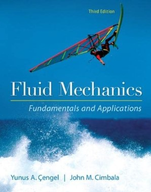Consider a modified form of Couette flow in which there are two immiscible fluids
Chapter 9, Problem 9-104(choose chapter or problem)
Consider a modified form of Couette flow in which there are two immiscible fluids sandwiched between two infinitely long and wide, parallel flat plates (Fig. P9104). The flow is steady, incompressible, parallel, and laminar. The top plate moves at velocity V to the right, and the bottom plate is stationary. Gravity acts in the 2z-direction (downward in the figure). There is no forced pressure gradient pushing the fluids through the channelthe flow is set up solely by viscous effects created by the moving upper plate. You may ignore surface tension effects and assume that the interface is horizontal. The pressure at the bottom of the flow (z 5 0) is equal to P0. (a) List all the appropriate boundary conditions on both velocity and pressure. (Hint: There are six required boundary conditions.) (b) Solve for the velocity field. (Hint: Split up the solution into two portions, one for each fluid. Generate expressions for u1 as a function of z and u2 as a function of z.) (c) Solve for the pressure field. (Hint: Again split up the solution. Solve for P1 and P2.) (d) Let fluid 1 be water and let fluid 2 be unused engine oil, both at 808C. Also let h1 5 5.0 mm, h2 5 8.0 mm, and V 5 10.0 m/s. Plot u as a function of z across the entire channel. Discuss the results.
Unfortunately, we don't have that question answered yet. But you can get it answered in just 5 hours by Logging in or Becoming a subscriber.
Becoming a subscriber
Or look for another answer
